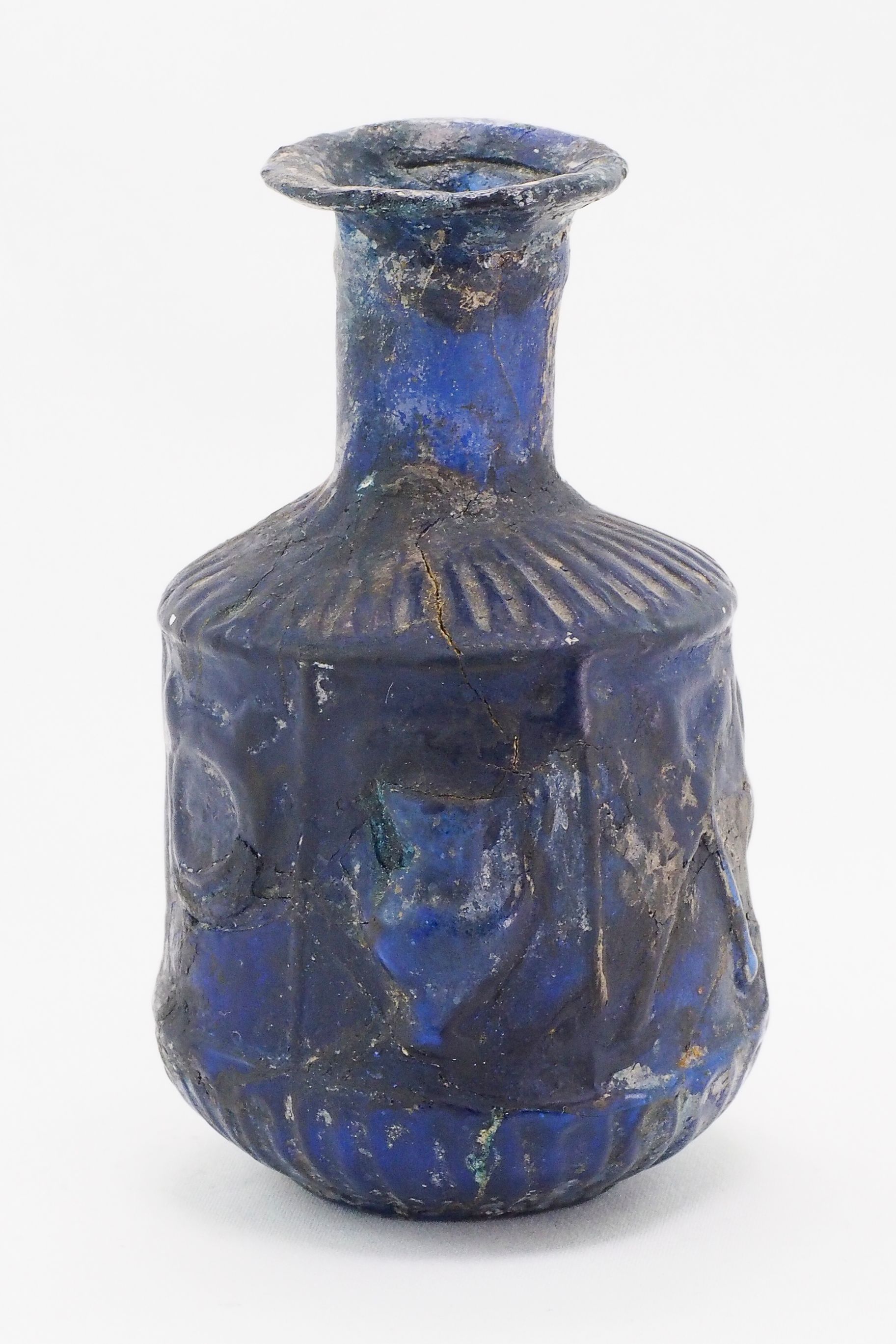Sidonian Flask
Name/Title
Sidonian FlaskEntry/Object ID
11NE-Mi59-195Description
The everted rim is uneven and folded inwards. The neck is short and cylindrical with a slight bulge just below the rim. The rim, neck, and downward-sloping shoulders with concentric incised downturned-tongues are free blown then attached to the hexagonal body. The body was blown into a three-part mold, each with two vertical sections. The mold seams are concealed within the decoration. On the body are six rectangular panels. From left to right: 1, an amphora with high handles and a conical foot; 2, crossed double-ended thyrsoi; 3, an amphora with high handles and a conical foot; 4, crossed double-ended thyrsoi; 5, an amphora with high handles and a conical foot; 6, a circular motif with twin projections towards the top. The three-part mold body was joined to a cup-shaped base which rounds from the body with concentric vertical incised ribbing. Three rings of concentric chill marks are on the underside of the flat base. A small recessed cylindrical cavity with a small boss at its center resides at the center of the underside of the base.Use
Dionysian Cult Practices, ReligiousContext
The dark blue colour is a popular style, characteristic of the Augustan period. Although, the finest bottles were made of opaque or glossy white glass to mimic marble. The hexagonal mold-blown vessel is a distinctive early form of glassware which used three molds in its construction. On the vessel, decoration pertained to three zones: the main frieze around the body which consisted of six panels; secondary decoration on the shoulder; and the lower third of the body. These hexagonal vessels appear in five different themes: vessels, masks, fruit, birds, and mixed symbols. The vessel type themes likely imitate an unidentified structure with six niches, whereas the fruit, masks, and mixed symbol types likely imitate hexagonal altars. Although hexagonal altars were not common in classical antiquity, several have been found in the Syro-Palestinian area and Asia Minor. In addition, the hexagonal shape of the body likely imitates religious architectural structures. This vessel is a mixed-symbol type which is decorated with Dionysian motifs. The crossed double-ended thyrsoi are two crossed spears. The shaft of the spear is typically depicted covered in ivy and attached to either end of the spear is a pinecone which conceals a point and a ferrule (the flora decoration on Dionysus' mythical campaign in India where his supporters concealed their spears using pinecones). In antiquity, the thyrsoi was believed to be used in Dionysian festivals in dances and processions. The double ended thyrsoi was not a common motif in Europe; instead it was popular in northern Palestine and Phoenicia, having been found on a second century CE altar to Dionysus in Beth Shean (the ancient city of Nysa-Skythopolis in Galilee). The amphora motifs are related to Dionysus as the god of wine as they were vessels used to store wine. The use of the amphorae on the main frieze panels could also indicate that they were sacred vessels used in Dionysian temples. Since the amphorae and thyrsois are symbols of Dionysus, it is likely that the circular motif of the sixth panel is also a Dionysian symbol or that of a syncretistic deity of the Near East. Most commonly the panels on Dionysian vessels with circular motifs appear as an instrument or a phiale (a libation bowl). However, this vessel's circular motif does not resemble any depictions of circular phiale dealt with and is thus still unidentified. The vessels of the mixed symbol types were made of metal mold instead of clay, which is identified by chill parks and a cylindrical cavity with a boss at the center on the underside of the base, in addition to punch marks around the symbols on the panels. The cup-shaped base was also likely turned on a lathe during its manufacturing, leaving the central cavity with a boss on the underside of the vessel. The lathe would have been used to turn the cup-shaped based along its vertical axis. In addition, this vessel is unique as most hexagonal vessels with Dionysian symbols do not repeat symbols on their panels; however, this vessel has two repeating symbols. Most vessels also come with a bifurcate or a trifurcate handle, classifying them as a juglet. This vessel does not have a handle, but it may have originally possessed a handle which may have been lost or was not included when the vessel was restored.Made/Created
Date made
1 CE - 100 CETime Period
Roman ImperialEthnography
Culture/Tribe
Near Eastern - Syro-Palestine

